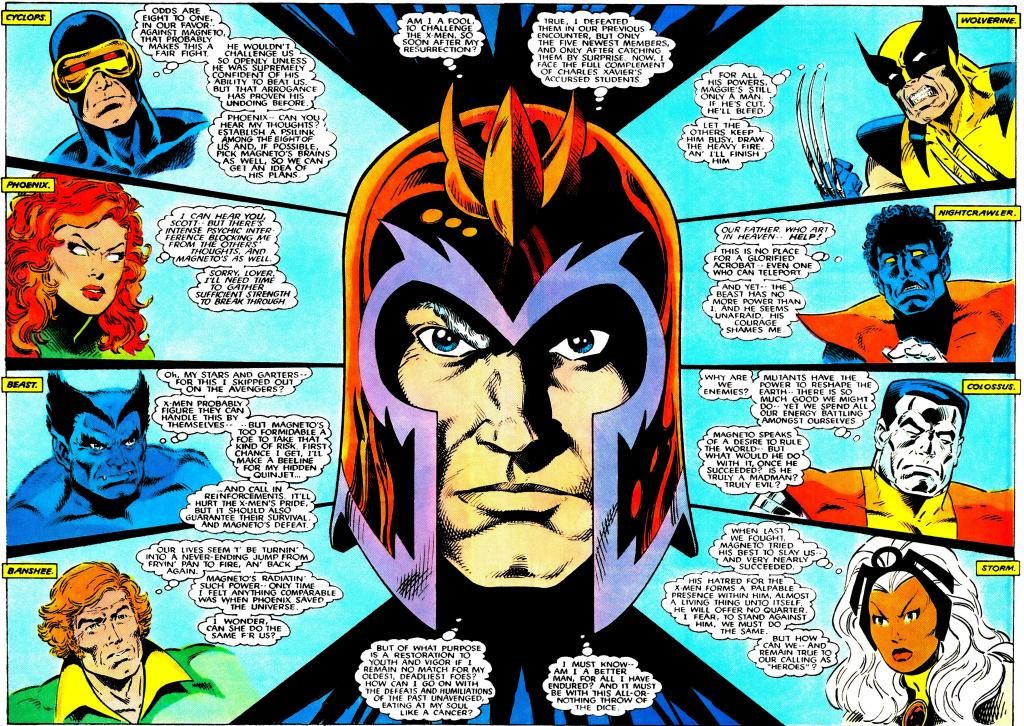Chris Claremont's writing style was really the house style for the X-Men until Grant Morrison arrived; even after Claremont was gone, writers were still expected to write like him. (When Joe Casey suggested doing some 1999 X-Men issues without thought balloons and captions, the editors told him no, and he said one assistant even laughed at him.) In the early '00s this style went from being house style to being considered very old-fashioned. But what do you think of this writing style? Do you enjoy reading it, or do you enjoy the classic X-Men in spite of it, or a bit of both?
What I think of when I think of the Claremont style is:
- Lots of thought balloons. Duh. Thought balloons for the characters' feelings, for exposition, for everything.
- Lots of narration, which is used not just to provide information and fill us in on what's going on, but to comment on the story and provide atmosphere and even have narrator catchphrases ("No quarter is asked...").
- A very direct way of writing, without a lot of subtext. Characters tell us exactly what they are thinking or feeling, often at great length.
Claremont didn't invent any of those devices, of course (the captions, in particular, were very much the house style at Marvel in the '70s) but the way he combined them is very much his own, and other X-writers like Louise Simonson and Scott Lobdell are obviously influenced by his way of doing things.
A classic Claremont double-page spread is this one from Classic X-Men 18:
What I like about this style is:
1. It places a value on clarity. Claremont always wants us to know what's going on. He would rather over-explain things than leave us wondering what happened. To me that's part of why his X-Men was so popular; no matter how complicated the plots get, it's always reader-friendly because the information we need is always there. Today's writers will not write a caption explaining what's going on in a panel, but the result is that some readers will look at it and wonder what the hell happened.
2. He spends so much time inside the head of every character that we always feel we know everyone intimately. A lot of writers feel that we should never see more than one character's POV at one time, but one of the great things about comics is you can show what everyone is thinking in one scene, and it makes you see that everyone has a different way of looking at things. Imagine X-Men 137 without all the thought balloons where the characters give their individual opinions on Jean and why they're fighting to help her. It wouldn't be the same.
What I don't like about the style is that by explaining everything, Claremont and his imitators removed all the possibility of subtext. Characters usually say exactly what they mean, and explain exactly how they feel. Whereas in novels and movies, and in more modern styles of comic writing, characters don't always say what they mean - sometimes they leave important things unsaid, or say the opposite of what they mean, or lie to themselves when they're thinking. Claremont doesn't seem comfortable doing that, and I understand why the next generation of comic book writers wanted to get a bit more subtle.
That's my perspective, anyway. I'd be interested to know what other people like and don't like about the Claremontian style. Or as Grant Morrison called it when he wrote his X-Men pitch, "an old-fashioned, over-dense style."
Results 1 to 15 of 52
Threaded View
-
02-03-2015, 02:00 PM #1Extraordinary Member

- Join Date
- May 2014
- Posts
- 5,723
 What do you like/dislike about the Claremont writing style?
What do you like/dislike about the Claremont writing style?






 Reply With Quote
Reply With Quote